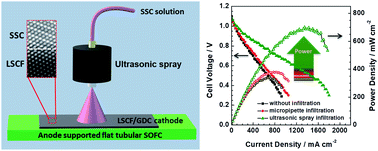Facile surface modification of LSCF/GDC cathodes by epitaxial deposition of Sm0.5Sr0.5CoO3via ultrasonic spray infiltration†
Abstract
A sluggish oxygen reduction reaction (ORR) is an inveterate challenge limiting the performance of solid-oxide fuel cells (SOFCs). Surface modification through the infiltration of nanoparticles is recognized as a facile technique to enhance the performance of state-of-the-art cathode materials. However, achieving stoichiometric uniformity and thermal stability of infiltrated nanoparticles needs further exploration. In this study, we demonstrate a novel ultrasonic spray infiltration technique to realize the surface modification of a La0.6Sr0.4Co0.2Fe0.8O3−δ/Gd0.1Ce0.9O2−δ composite cathode through the infiltration of a Sm0.5Sr0.5CoO3−δ cathode catalyst. Infiltration by this new technique dramatically reduces the area-specific ohmic and polarization resistances, resulting in twofold enhanced performance of the anode-supported SOFC. In contrast, only a slight increase in the performance is achieved by infiltration through a micropipette. The performance improvement through ultrasonic spray infiltration is attributed to the uniform dispersion of the catalyst in the form of a nanolayer. Moreover, TEM analysis has revealed an epitaxial deposition of Sm0.5Sr0.5CoO3−δ forming a layered perovskite structure at the La0.6Sr0.4Co0.2Fe0.8O3−δ/Sm0.5Sr0.5CoO3−δ interface leading to sustained high-performance outcomes. On the contrary, infiltration by micropipette did not produce such uniform morphology of infiltrated nanoparticles and also indicated elemental segregation giving rise to impure phase formation. The ultrasonic spray infiltration technique proposed here represents a viable and commercializable solution to produce SOFCs with high and stable performances.



 Please wait while we load your content...
Please wait while we load your content...